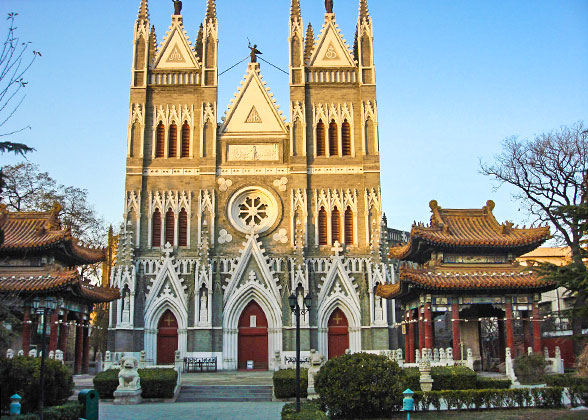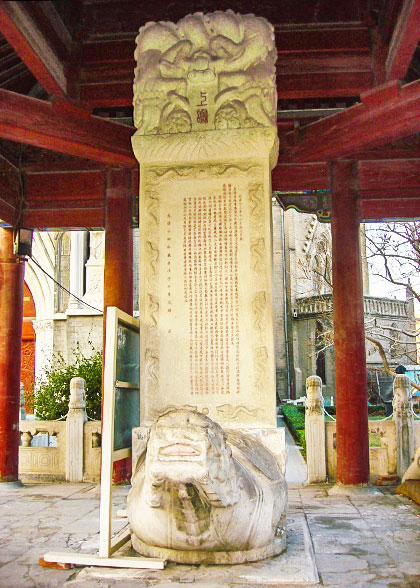Church of the Saviour, Beijing
 |
| Church of the Saviour, Beijing |
The main architecture of the church is a three-storey Gothic building. Covering an area of 2,600 square yards (2,200 square meters), it can accommodate 1,000 people at one time. If looking down, it resembles a cross. Below the Gothic architecture is the conventional Chinese stylobate, which is surrounded by white-marble guardrails. The guardrail and the patterns on it are also in traditional Chinese style. Two Chinese-style pavilions with yellow glazed tile roofs stand systematically on both sides of the Gothic building. Inside the pavilions, four Chinese stone lions and stone tablets can be found. The characters on the tablets were written by Emperor Qianlong of the Qing Dynasty (1644-1911). Looking at a distance, you will marvel at the ingenious combination of Chinese and Western architecture styles.
 |
Inside the Xishiku Cathedral, 36 pillars with a height of 52 feet (15 meters) are used to prop up the golden roof. The top of the pillar is in the shape of cabbage leaves. Around the hall, there are 80 glass windows. The golden roof and the windows with colorful-inlaid glasses make you immerse in the solemn religious atmosphere. The painting of the "Virgin and Child" in different clothes can be seen here. The main altar and matching altar are located in the main hall. Behind the front door of the main hall is the Choir. To the north of the main altar lies the Suffering Hall. The replica of the "Last Supper" is hung in the shadow of the entrance. When going out, it comes into view. The names of twelve followers are labeled in the painting.
In addition to the main gothic building and two Chinese pavilions in its front, Xishiku Church used to have many subsidiary buildings including a library, back garden, printing house, orphanage, hospital, school, and convent. However, only the convent is in use nowadays. It is located to the northwest of the church.
Mass (All in Chinese)
| Monday to Saturday | 06:00, 07:00 |
| Sunday | 06:00, 07:00, 08:00, 10:00, 18:00 |
How to Get to Church of the Saviour
2. Take bus no. 14, 38, 55, 101, 103, 109, 124, or 685 to Xi'anmen Station. And then walk 200 yards (180 meters) northward to the church.
Beijing Bus / Subway Search
| Admission Fee | Free |
| Opening Hours | 05:00 – 18:00 |
- Last updated on Sep. 19, 2024 by Kate Liu -